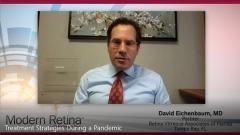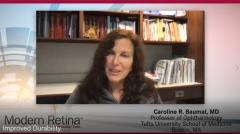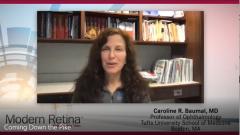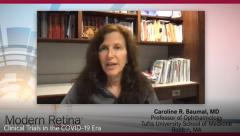
Real-World Experiences and Clinical Trials: Why Outcomes Differ
Episodes in this series

Caroline R. Baumal, MD: Now I'd like to talk about treatment paradigms for neovascular AMD, David. We have so many results from pivotal phase 3 studies that led to approval of anti-VEGF agents, and then there have been so many studies in the literature. More recently, we've had a lot of real-world studies looking at large populations, and the results often differ by the number of letters of improvement, by less anti-VEGF injections in the real world. How do you interpret this data and use it in your practice?
David Eichenbaum, MD: That's a great question. We see this in the CATT extension study. We see this back at HORIZON and SAILOR. We see it in SEVEN-UP, and we see when patients move from the clinical trial setting where they're getting protocol mandated doses; they're encouraged to come in. We have a coordinator shepherding them through frequent visits, and then they switch into some type of real-world dosing setting that are followed, but their visual acuity drops off, and that is disconcerting. It's always been disconcerting, and we've always correlated that to the frequency of injections in the clinical trials.
Now are there other factors at play? Is there atrophy as they're aging? Sure, there's all this other stuff that happens, but we consistently see a correlation when we convert patients from randomized controlled trial dosing to real world style dosing or preference dosing with a reduction in acuity. Then when you combine that with data like Frank Holz's real world study from Europe and seeing the injection frequencies in different countries correlated to different visual acuity outcomes, it continues to emphasize this thought that in general more injections of our current agents are better.
Now that of course runs counter to the pressures that the real world puts on our patients and on our clinics and puts on the payers to keep up with the frequent dosing, so as far as treatment strategy goes, I feel like I'm an ardent and conservative treatment extender like the vast majority of retina specialists with some notable exceptions per the Preferences and Trends Survey. The vast majority of American retina specialists are treatment extenders. How do you interpret all the real-world data? Do you dose the same way for your average wet AMD patient? What do you take away from all that?
Dr. Baumal: There's something that the studies just don't capture, and that is that our patients are getting older, their visual needs change—and all the coexisting health problems that they might have and the other demands on their life. I think that it's very, very hard for most people to maintain every-4-week dosing, which is why what we see in the real world never approximates what we see in the clinical studies. But the studies have shown again and again that more frequent, regular dosing typically leads to better visual results and dry OCT.
I'd say that I really try to treat my patients frequently, especially if they only have one good eye, if their other eye’s already been affected by exudative macular degeneration with a scar or they have some other pathology. I try to keep ahead of what they saw in the real-world study. Some of the real-world studies patients had very few injections per year, and I think that might relate in some way to the countries where people were reporting these studies from or different physician treatments. Some physicians still treat PRN, but I think that we should try to treat patients frequently if they need it which really is many of my patients.
Dr. Eichenbaum: We had a review of our practice provided by a vendor, and they mined our electronic medical records (EMR). They correlated our average number of letters gained with more than 6 injections in the first year of treatment and less than 6 injections in the first year of treatment. Even in our little microcosm of data we had much better visual acuity by the factor of a line, and the average visual acuity at the end of the first year of treatment with the more frequent injections.
It's hard because you’ve got to keep that up, but the more we see about frequency of injections, the more it makes me think we should frequently inject. With those binocular patients I won’t extend beyond their fluid recurrence interval, even if it's relatively frequent. With binocular patients when they recur it’s a discussion, you know, how many times do you challenge them with an extension? I will give them an opportunity more than once, but not three or four times to see them keep recurring and potentially losing vision.
Caroline R. Baumal, MD: Hello and welcome to this discussion presented by Modern Retina and Ophthalmology Times titled, “Treating Age-Related Macular Degeneration in 2020. I'm Dr. Caroline Baumal. I'm a Professor of Ophthalmology at Tufts University School of Medicine in Boston. Please welcome—okay.
Please join me in welcoming my colleague, and not only my colleague but an ex-fellow from Tufts and a good friend of mine, Dr. David Eichenbaum, who is currently a partner at Retina Vitreous Associates of Florida in Tampa Bay. In today's discussion we'll talk about available therapies and some that are still in development as well as practical considerations in treatment of wet AMD during the post-pandemic era.
Newsletter
Keep your retina practice on the forefront—subscribe for expert analysis and emerging trends in retinal disease management.









